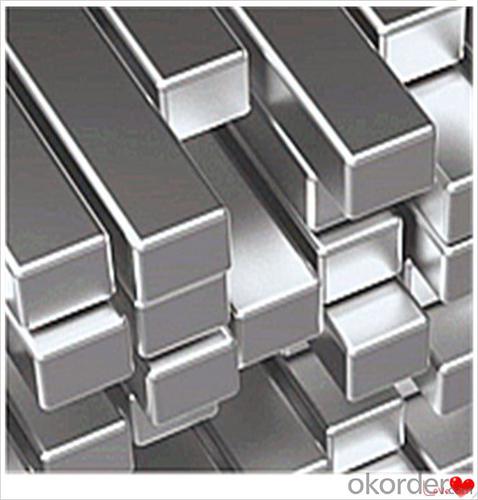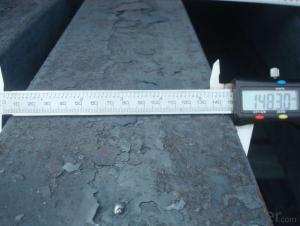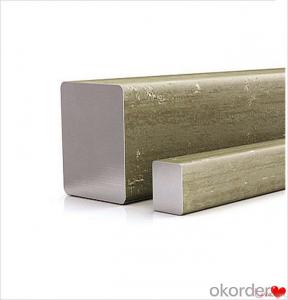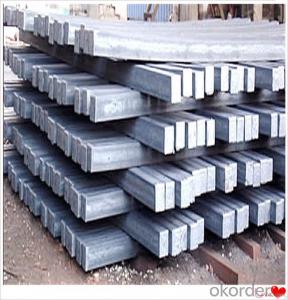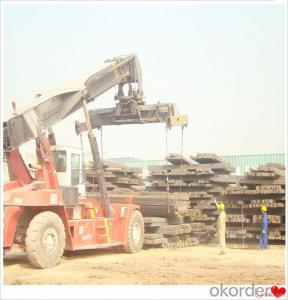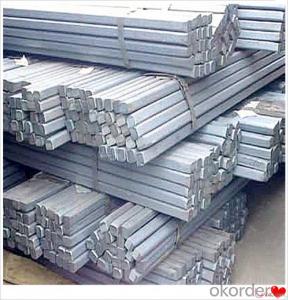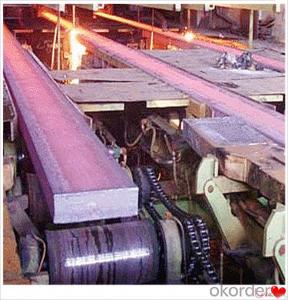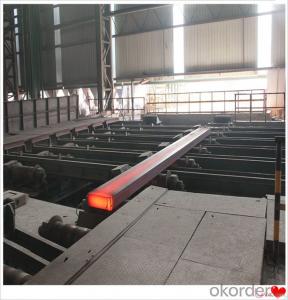Billet Bicycle Wheel Q235,Q255,Q275,Q345,3SP,5SP,20MnSi
- Loading Port:
- China main port
- Payment Terms:
- TT OR LC
- Min Order Qty:
- 20 m.t.
- Supply Capability:
- 200000 m.t./month
OKorder Service Pledge
OKorder Financial Service
You Might Also Like
Billet Bicycle Wheel Q235,Q255,Q275,Q345,3SP,5SP,20MnSi
Specification
Steel billet(ingot) by cogging or breakdown of semi-finished products, is the raw material of all kinds of steel mill. Billet section of square, round, flat, rectangular and abnormity of several kinds of, mainly related to the shape of rolled products.
CNBM Q235,Q275,Q345,3SP,5SP,20MnSi Billets Steel
Hot Rolled Steel Billets/ Mild Steel Bar/ Billet Steel
Specification (see below)
Standard: GB/JIS/ASTM
Size: 50*50mm-180*180mm
Length: 3-12mtrs or Customised
Steel material: Q235,Q255,Q275,Q345,3SP,5SP,20MnSi
Technique: Hot rolled
FOB Unit Ton Price $250-350 and Usually I will quote you CFR price.
MOQ: Usually 1000-10000MT/size
Shipment:By Container,Bulk Vessel
Packaging Details: bundles with steel strips or as customers's requirements
Delivery time: Usually within 30 days after the deposit/LC
Inspection:Third party inspection before loading.
Technical data
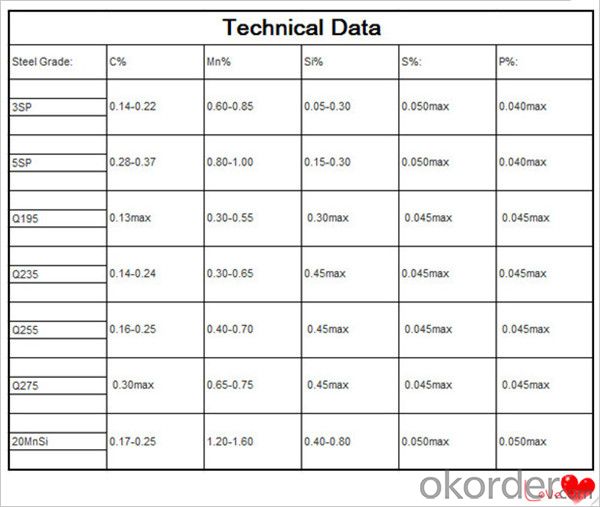
Feature Steel Billet
Rectangular billet continuous casting billet and mainly general carbon steel, low carbon low silicon cold-rolled material, high quality carbon structural steel, high strength low alloy steel, special steel, etc.
The billet is mainly divided into two kinds from the shape:
Slab: cross section width and height of the ratio of the larger, mainly used for rolling plate.
Billet: equal cross section width and height, or a huge difference, mainly used for rolling steel, wire rod. ,
Steel billets have distinct characteristics as compared with already furnished steel bars and products. Billets have a specific grain structure, which enables the metal to be processed more intricately. Steel billets are also known for their malleability and ductility, especially when exposed to varying temperatures during shaping and molding.
Packaging & Shipping
1. Packaging:
1) Small size: in bundles
2)Big size: in bulk
3)in plastic packing or as per customer requirement
2. Delivery time:
1) Normal size: within 7days send from warehouse directly
2) Special size: with 25-30days customer made for you
3. Trade terms:FOB/CFR/CIF
4. Shippment:
1) length:≤5.8m loaded in 20FT Container with 25-27tons
2) length:≤11.8m loaded in 40FT Container with 25-27tons
3) lengnth:≥12m shipped by bulk vessel, FILO terms
Steel Billet Images
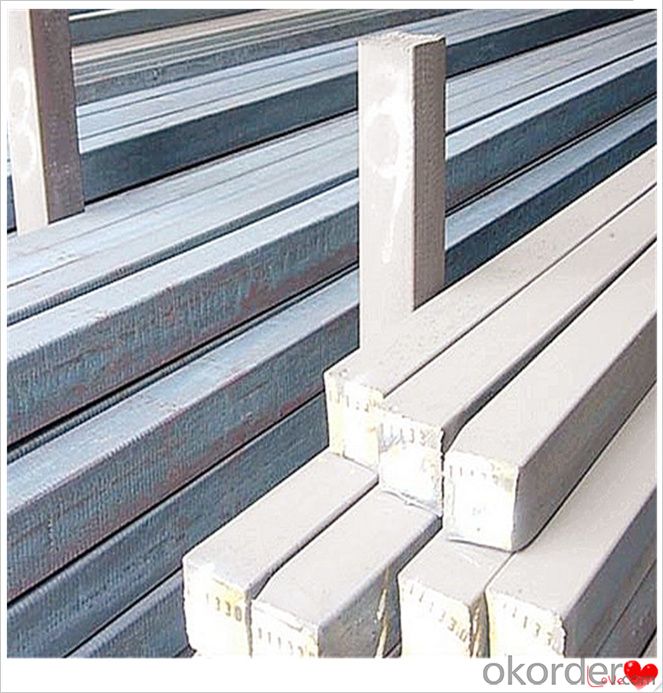
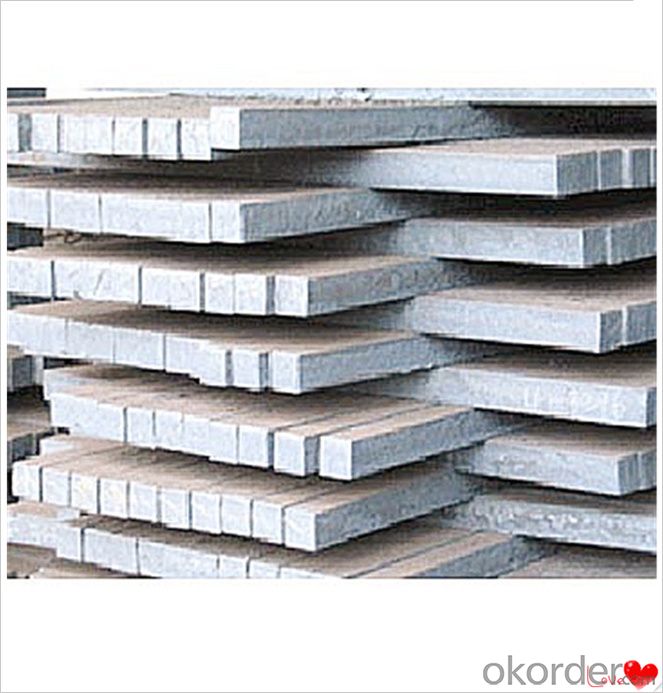
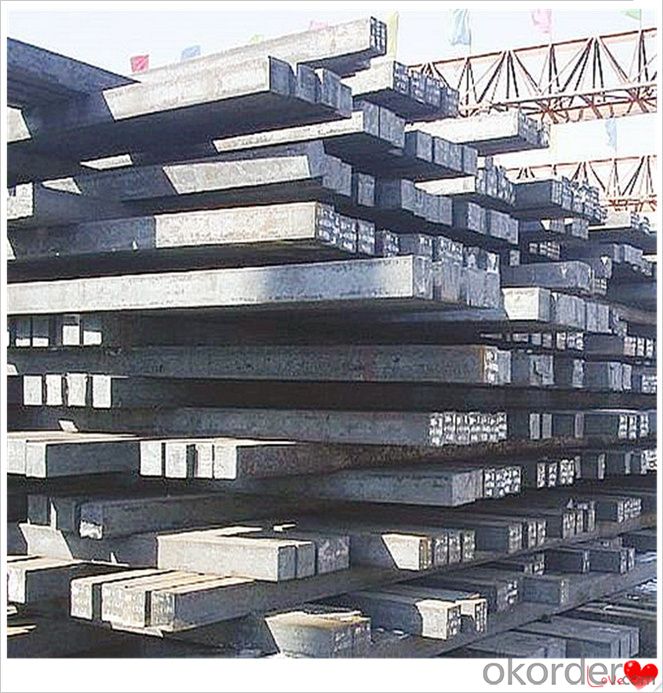
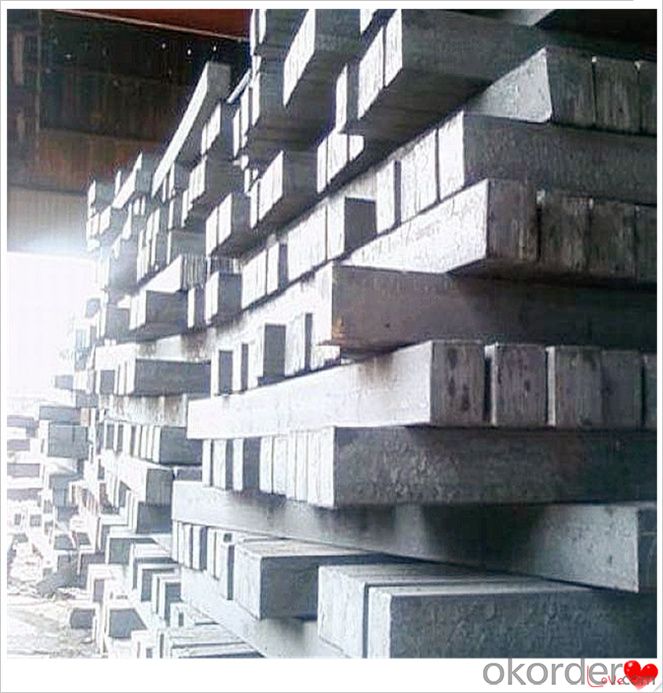
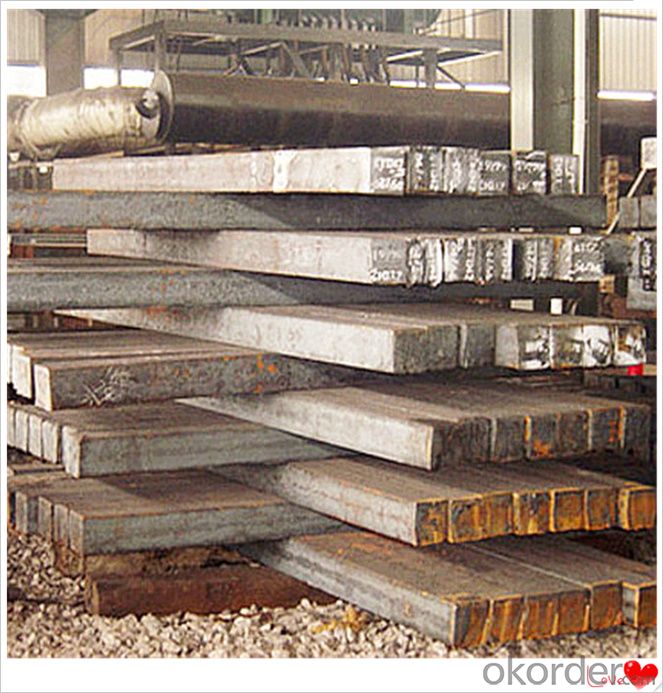
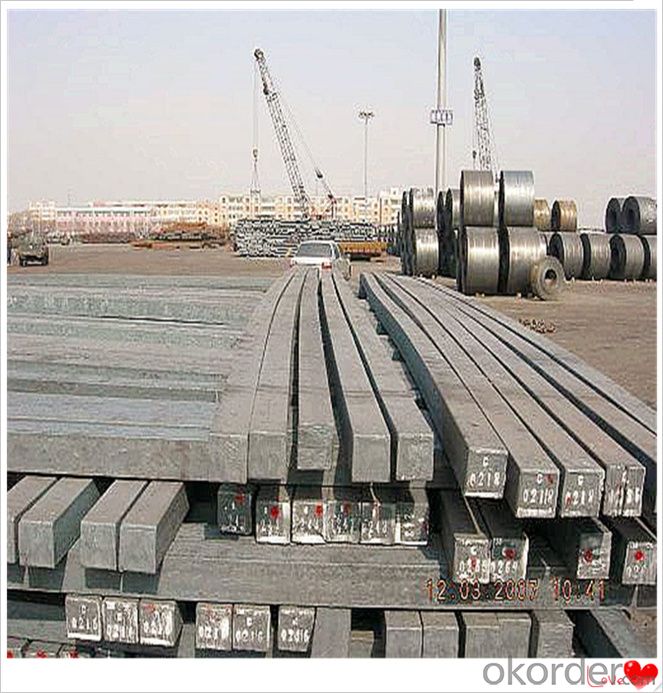
Processing
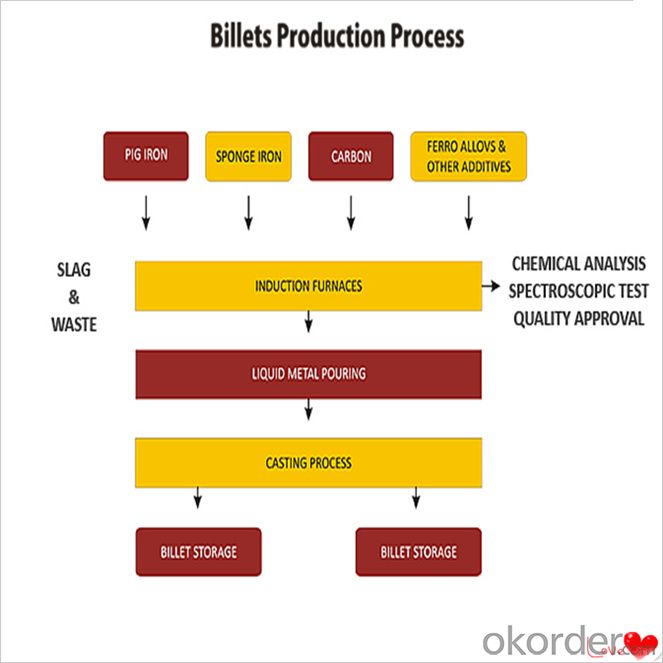
Usage-Billet Steel
Used for the plant, the bridge,shipment building high-rise building construction,lifting and transportation machinery, equipment manufracturing base building the support foundation pile manufacturing.
Billets, or ingots (as they sometimes referred to), are not of practical use until they have been formed into more functional shapes and sizes. While they have already been put in the furnace, they still require a series of shaping and molding procedures such as hot and cold working, milling and cutting before they are sold in hardware stores, or used for different applications. The unformed billets, however, can be used in striking currency such as coins and as reserves, similar to gold bars.
FAQ-Billet Steel
We have organized several common questions for our clients,may help you sincerely:
1) How about your company?
A world class manufacturer & supplier of castings forging in carbon steel and alloy steel,is one of the large-scale professional investment casting production bases in China,consisting of both casting foundry forging and machining factory. Annually more than 8000 tons Precision casting and forging parts are exported to markets in Europe,America and Japan. OEM casting and forging service available according to customer’s requirements.
2) How to guarantee the quality of the products?
We have established the international advanced quality management system,every link from raw material to final product we have strict quality test;We resolutely put an end to unqualified products flowing into the market. At the same time, we will provide necessary follow-up service assurance.
3) How long can we receive the product after purchase?
In the purchase of product within three working days, We will arrange the factory delivery as soon as possible. The pecific time of receiving is related to the state and position of customers.Commonly 7 to 10 working days can be served.
4)Do you have your own QC department?
Yes, we have, our QC department will inspect the goods during the process of mass production and after completion of production.
hot sale!!! Cast Steel Grades/ mild steel bar/ billet steel
(1): High quality steel with reasonable price.
(2): Wide excellent experiences with after-sale service.
(3): Every process will be checked by responsible QC which insures every product's quality.
(4): Professional packing teams which keep every packing safely.
(5): Trial order can be done in one week.
(6): Samples can be provided as your requirements.
- Q: What are the main factors affecting the tensile strength of steel billets?
- There are several main factors that affect the tensile strength of steel billets. Firstly, the composition of the steel plays a significant role. The presence of certain elements, such as carbon, manganese, and silicon, can greatly influence the strength of the steel. Carbon, in particular, is a key element in increasing the strength of steel through its ability to form strong interatomic bonds. Secondly, the heat treatment process employed during the production of steel billets is crucial. Heat treatment, such as quenching and tempering, can significantly enhance the tensile strength of the steel by manipulating its microstructure. Quenching involves rapidly cooling the steel, which creates a hardened structure, while tempering involves reheating the steel to a specific temperature to achieve the desired balance of hardness and toughness. Additionally, the grain size of the steel also affects its tensile strength. Fine-grained steel generally exhibits higher strength due to the increased number of grain boundaries, which act as barriers to dislocation movement. On the other hand, coarse-grained steel tends to have lower strength as it allows for easier dislocation movement. Moreover, the presence of impurities or defects in the steel can weaken its tensile strength. Inclusions, such as sulfur, phosphorus, and non-metallic inclusions, can act as stress concentration points and promote crack initiation, leading to reduced strength. Similarly, the presence of voids, porosity, or other structural defects can compromise the overall strength of the steel billets. Lastly, the processing conditions during the manufacturing of steel billets can affect their tensile strength. Parameters such as rolling and forging temperatures, deformation rate, and cooling rate can influence the resulting microstructure and, consequently, the strength of the steel. In conclusion, the main factors affecting the tensile strength of steel billets include the steel composition, heat treatment process, grain size, impurities or defects, and processing conditions. Understanding and optimizing these factors are crucial for producing steel billets with the desired mechanical properties.
- Q: What are the different surface treatment methods used for steel billets?
- Steel billets undergo various surface treatment methods to enhance their properties and optimize their performance. Some commonly employed techniques include: 1. Pickling: By immersing steel billets in an acid bath, typically hydrochloric or sulfuric acid, any scale or oxides on the surface are effectively removed. This method improves surface finish and prepares billets for subsequent processing. 2. Shot blasting: High-velocity steel shots are used to subject steel billets to remove rust, scale, or contaminants from the surface. This method not only cleans the surface but also enhances its roughness, facilitating better adhesion of coatings or paints. 3. Phosphating: Applying a phosphate coating chemically onto the surface of steel billets is known as phosphating. This coating provides corrosion resistance and enhances paint adhesion. Phosphating is commonly employed as a pre-treatment method before applying organic coatings. 4. Galvanizing: A widely-used surface treatment method involves coating steel billets with a layer of zinc, known as galvanizing. This process ensures excellent corrosion resistance and safeguards the steel against environmental factors. Galvanized steel billets find extensive use in outdoor applications and industries where rust prevention is crucial. 5. Electroplating: Electroplating involves depositing a thin layer of metal, such as chromium or nickel, onto the surface of steel billets using an electric current. This method enhances aesthetic appearance, corrosion resistance, and wear resistance of the steel billets. 6. Coating: To provide a protective layer on the surface of steel billets, coating techniques such as painting, varnishing, or applying protective coatings are utilized. These coatings act as a barrier against corrosion, abrasion, and other forms of damage. Coatings can be applied using methods like spraying, dipping, or powder coating. 7. Passivation: Passivation is a chemical process employed to eliminate free iron and other contaminants from the surface of steel billets. This process aids in restoring the steel's passive film, which enhances corrosion resistance. Passivation is commonly employed in stainless steel billets to augment their resistance to rust and corrosion. These surface treatment methods significantly contribute to improving the quality, durability, and performance of steel billets, rendering them suitable for diverse applications across industries such as construction, automotive, and manufacturing.
- Q: How are steel billets inspected for surface defects?
- To ensure the quality and integrity of steel billets, a variety of methods and techniques are employed to inspect them for surface defects. One way is through visual inspection, where trained inspectors carefully scrutinize the billets for any visible flaws such as cracks, scratches, pits, or unevenness. They utilize appropriate lighting and magnification tools to conduct a thorough examination of the entire surface. Another method in use is dye penetrant testing. This involves applying a liquid dye to the billet's surface, allowing it to seep into any cracks or defects. After a designated period, excess dye is removed and a developer is added. The developer brings out the dye from any defects, making them clearly visible and easily identifiable. Magnetic particle inspection is another widely utilized technique. During this process, the billets are magnetized, and iron particles are applied to the surface. Any surface flaws disrupt the magnetic field, causing the iron particles to gather around the defect, thus making them easily detectable upon inspection. This method proves particularly effective for identifying defects such as surface cracks. Ultrasonic testing is also commonly employed to inspect steel billets. It entails transmitting high-frequency sound waves through the material, which then produce reflections or echoes when encountering any surface defects or internal flaws. These reflections are detected and analyzed, providing valuable information about the defect's size, location, and type. Furthermore, eddy current testing can be utilized to inspect steel billets for surface defects. This method involves passing an alternating current through a probe positioned near the billet's surface. Any defects or variations in the material's conductivity cause changes in the eddy currents, which can be detected and analyzed to identify surface defects. In conclusion, steel billets undergo meticulous inspection utilizing a combination of visual, dye penetrant, magnetic particle, ultrasonic, and eddy current testing methods. This ensures that any surface defects are promptly identified and addressed, thereby guaranteeing the quality and reliability of the final product.
- Q: What are the different surface defects in steel billets?
- Steel billets can have various types of surface defects, which can occur during manufacturing or due to handling and transportation. Some common defects include scale, cracks, lamination, pitting, slivers, rolled-in scale, and surface scratches. Scale forms as a rough, flaky coating during heating and rolling, affecting the billet's appearance. Cracks can be caused by improper cooling, excessive pressure, or stress during handling, compromising the billet's strength. Lamination defects occur when non-metallic layers weaken the billet. Pitting is the formation of small cavities due to corrosion or exposure to corrosive environments. Slivers are thin, protruding pieces caused by improper cutting or shearing. Rolled-in scale refers to embedded scale, requiring additional cleaning. Surface scratches are shallow marks that can affect aesthetics and may need further treatment. Proper identification, handling, and treatment of these defects are essential to ensure the quality of the steel billets. Regular inspection and appropriate techniques can minimize defects and enhance the billets' overall quality.
- Q: How do steel billets compare to other forms of raw steel material?
- Steel billets possess unique advantages when compared to other forms of steel. Their exceptional strength and durability are well-known. They are manufactured using a meticulously controlled process that ensures uniform composition and consistent grain structure, resulting in superior mechanical properties. Consequently, steel billets are highly suitable for industries requiring robust and dependable steel, such as construction, automotive, and manufacturing. Additionally, steel billets offer remarkable machinability. Their uniform shape and size facilitate easy handling and processing, thereby reducing waste and improving production efficiency. This proves especially advantageous for manufacturers utilizing precision machining techniques to create intricate and complex components. Another benefit of steel billets lies in their versatility. They can be forged, rolled, or extruded into various shapes and sizes, allowing for customization according to specific requirements. This adaptability renders steel billets suitable for an extensive range of applications, ranging from structural beams and bars to pipes and rods. Moreover, steel billets boast a relatively low carbon content, making them more ductile compared to other forms of raw steel material. This enhanced ductility enables simpler shaping and forming, making steel billets particularly appropriate for hot working processes like forging and rolling. In summary, steel billets offer numerous advantages over other forms of raw steel material. Their high strength, excellent machinability, versatility, and ductility make them the preferred choice for many industries. Whether it is for structural purposes or the manufacturing of complex components, steel billets possess the necessary properties and flexibility to meet a wide range of requirements.
- Q: How are steel billets used in the manufacturing of pipes?
- Steel billets are an essential component in the manufacturing of pipes. These billets, which are semi-finished products made of steel, serve as the raw material for pipe production. The process begins with the selection of high-quality steel and melting it in a furnace to create a molten steel alloy. Once the steel is molten, it is poured into molds to form billets of specific sizes and shapes. The billets are then allowed to cool and solidify. This solidification process ensures that the steel attains its desired structural properties, such as strength and durability. After the steel billets have cooled, they undergo further processing to transform them into seamless or welded pipes. For the production of seamless pipes, the billets are heated and pierced to create a hollow tube-like structure. The pierced billets are then elongated and stretched to obtain the desired pipe diameter and thickness. This process, known as the hot-rolling technique, results in seamless pipes with consistent dimensions and enhanced mechanical properties. Welded pipes, on the other hand, are manufactured using different methods. One common method is the electric resistance welding (ERW) process, where the billets are first heated and then passed through a series of rollers to shape them into a cylindrical form. The edges of the billets are then fused together using an electric current, creating a continuous weld. Other welding techniques, such as submerged arc welding (SAW) and high-frequency induction welding (HFIW), can also be used to manufacture welded pipes from steel billets. In both seamless and welded pipe manufacturing, the quality of the steel billets is crucial for ensuring the integrity and performance of the final product. The selection of appropriate steel grades and the adherence to strict manufacturing standards are vital to produce pipes that can withstand high pressure, extreme temperatures, and corrosive environments. In conclusion, steel billets play a vital role in the manufacturing of pipes. They serve as the starting material from which pipes are formed, whether through the hot-rolling technique for seamless pipes or various welding methods for welded pipes. By utilizing high-quality steel billets and employing precise manufacturing processes, pipes can be produced with the necessary strength, durability, and dimensional accuracy to meet a wide range of industrial and commercial applications.
- Q: What are the different types of steel used for manufacturing billets?
- Manufacturing billets commonly employ various types of steel, each possessing unique properties and applications. Some frequently utilized steel types for this purpose encompass: 1. Mild Steel: Widely employed for billet manufacturing, mild steel exhibits low carbon content and is renowned for its strength and ductility. It suits general-purpose applications that do not necessitate high strength. 2. Carbon Steel: Containing higher carbon levels than mild steel, carbon steel offers enhanced hardness and strength. Hence, it is suitable for wear-resistant applications like tools and machinery components. 3. Alloy Steel: Alloy steel is produced by incorporating diverse alloying elements, including manganese, nickel, chromium, or molybdenum, into the base iron. Consequently, it exhibits augmented strength, durability, and corrosion resistance. The automotive, aerospace, and construction industries typically employ alloy steel billets. 4. Stainless Steel: Stainless steel is an alloy comprising at least 10.5% chromium, which endows it with remarkable resistance against corrosion and staining. Consequently, it is ideal for applications requiring high hygiene levels, such as food processing equipment and medical devices. 5. Tool Steel: Tool steel, a high-carbon steel, is specifically engineered for tool, die, and mold production. It is renowned for its hardness, wear resistance, and ability to retain shape at elevated temperatures. 6. High-Speed Steel: This type of tool steel is designed to endure high temperatures without compromising its hardness. It is frequently employed for cutting tools like drills and milling cutters. These examples merely represent a fraction of the steel types utilized for billet manufacturing. The selection of steel hinges upon specific requirements, such as strength, durability, corrosion resistance, and temperature resistance, dictated by the application at hand.
- Q: How do steel billets contribute to the manufacturing of automotive components?
- Steel billets play a crucial role in the manufacturing of automotive components. These billets, which are semi-finished metal pieces, serve as the starting material for the production of various automotive parts. One of the main ways steel billets contribute to automotive component manufacturing is through the process of forging. Forging involves shaping the metal billets under high pressure and temperature, typically using a hammer or a press, to create the desired automotive parts. This process helps in enhancing the strength, durability, and reliability of the components, making them suitable for the demanding conditions of the automotive industry. Steel billets are also used in the production of engine components such as crankshafts, connecting rods, and piston rods. These parts require high strength and resistance to wear and tear, which are achieved by starting with high-quality steel billets. By using steel billets as the raw material, automotive manufacturers can ensure that the resulting components have the necessary mechanical properties to withstand the stresses and forces experienced by the engine during operation. Furthermore, steel billets are employed in the manufacturing of suspension components, such as control arms and stabilizer bars. These components are responsible for maintaining the stability, handling, and comfort of the vehicle. Using steel billets in their production ensures that the suspension components can withstand the heavy loads and impacts encountered on the road, providing a smooth and safe driving experience. Additionally, steel billets contribute to the manufacturing of safety-related automotive components. For instance, they are used in the production of structural components like chassis frames and body reinforcements. These components are essential for protecting the occupants in the event of a collision or impact, and steel billets provide the necessary strength and rigidity to ensure their effectiveness. In conclusion, steel billets are a vital element in the manufacturing of automotive components. They enable the production of strong, durable, and reliable parts, ensuring the overall performance, safety, and longevity of vehicles. By starting with high-quality steel billets, automotive manufacturers can meet the demanding requirements of the industry and deliver high-performance vehicles to consumers.
- Q: How are steel billets used in the production of bars and rods?
- Steel billets are used as a raw material in the production of bars and rods. They are first heated and then passed through a series of rolling mills to be shaped into the desired form. This process increases the strength and durability of the steel, making it suitable for various applications such as construction, manufacturing, and automotive industries.
- Q: Billet market trend
- 3, Tangshan billet inventory declineIt is understood that in April, the Tangshan region began to decline in the stock of major steel warehouse, as of April 28th, Tangshan billet inventory at about 1 million 250 thousand tons, a drop of about half higher than the high point. But some vendors have revealed that some of the resources are being transferred from the warehouse to the traders. In fact, inventories are much larger than statistics, and the inventory of 1 million 250 thousand tons of steel is about 2.5 times that of the same period of last year.In addition, network analyst China industry insight believes the macroeconomic situation, the weakening of steel and steel industry more negative news of the credit crisis will be unfavorable to the billet market outlook. But considering the steel production has been at a loss, the billet has a certain resilience; and before the May Day holiday billet prices fell rapidly, it is possible to pull up the opportunity to play after the manufacturers in a certain way.
Send your message to us
Billet Bicycle Wheel Q235,Q255,Q275,Q345,3SP,5SP,20MnSi
- Loading Port:
- China main port
- Payment Terms:
- TT OR LC
- Min Order Qty:
- 20 m.t.
- Supply Capability:
- 200000 m.t./month
OKorder Service Pledge
OKorder Financial Service
Similar products
Hot products
Hot Searches
Related keywords






